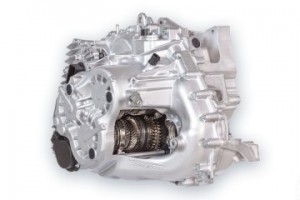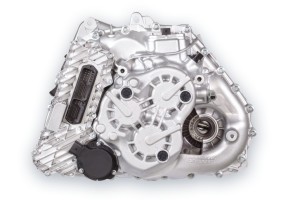Getrag Plans a Big Future for the 7DCT300
Getrag, which was taken over by Magna in July, is preparing to challenge competitors in the automatic transmissions market once again with the launch of the new wet clutch DCT300 architecture. At the VDI transmissions congress in June 2015, Getrag’s Ernie DeVincent joined forces with Renault VP of transmission projects, Frédéric Martin, to present the new transmission and outline details of the partnership between the two companies.
Getrag’s highly efficient new 7DCT300 entered production in Europe early in 2015, with start of production in China for the Asian market planned for 2017. A hybrid version of the transmission will enter production in the third quarter of 2018 and the first use will be in the new Renault Espace, with deployment in other Renault models and other OEM products at a later date. Over 100 applications are planned for the new transmission already, and Getrag is not only claiming best in class performance but also that the 7DCT300 has the greatest commercial potential in the company’s history.
The new 7DCT300 enters production
This third-generation DCT is based on a new modular platform and is claimed to be 3.5 per cent more efficient than previous generation DCTs. The compact transmission is designed for front-wheel drive applications, and its headline statistics include a torque capacity of 300 Nm and electrical energy consumption of just 30 W — powering electric motors to shift gears and an electro-hydraulic system to power the clutches.
World-Class Consumption and Comfort
DeVincent opened his lecture at VDI with a presentation entitled, “Towards World-Class Consumption and Comfort,” outlining the evolution of DCT technology from Getrag’s first six-speed wet clutch product in 2007 through the second, more efficient generation of dry clutch technology in 2010 to this, the third generation. The latest version has electrohydraulic on-demand smart shift actuation, with its breakthrough low energy consumption; the earlier versions were fully hydraulic and fully electromechanical, respectively.
Getrag identifies the following key market factors in the success of DCT technology: improvements in fuel economy and the reduction of CO2 emissions; delivering added value features and weight reduction.
CO2 improvements have been achieved by the use of a highly efficient gear set, flexible gear ratio choices, an intelligent gear ratio span, extended “sailing” functionality and active thermal management. Extended features include the inclusion of all-wheel drive, enabling features for park-by-wire, start-stop and the capability to accommodate an integral electric machine to provide hybrid functionality. The hybrid features are based on the forthcoming 48-volt electrical architecture capable of delivering high power solutions and improved economy.
The needs of both the customer and the OEM are driving future development. Seven speeds are essential for mid-segment cars, said DeVincent; upscale brands also need a hybrid option and some require a wet clutch (depending on torque output). Modularity across platforms supports volume of scale for the OEM and creates greater choice for the end user. Compact package size is important and so is low weight to help reduce the weight spiral and further reduce fuel consumption and CO2: the 7DCT300 weighs only 67 kg dry.
The compact DCT300 architecture is designed for front-wheel drive
There should be a focus on the fun factor with future transmissions, too, says Getrag. Increased launch performance, increased engine input speed (to accommodate sportier, higher revving engines) improved low speed refinement and lower inertia all play a part.
The 7DCT300 supports all of these concepts and features. The input torque capacity of 300 Nm makes it ideal for mid-segment cars, it has a wet-nested dual clutch for refinement and low wear rates, and a wide gear ratio span of 8.5. The seven forward speeds ensure good acceleration combined with relaxed cruising at high speed.
Even the base design incorporates start-stop, sailing and mechanical park lock. Optional features include a range of hybrid options to support anything from mild hybrid to full plug-in applications.
A key aspect of the design is the nested dual clutch module, which is both oil cooled and lubricated to support the high torque input. Inertia has been reduced by 70 per cent compared to second generation transmissions and the unit can cope with a maximum engine speed of 7,000 rpm. Each clutch is independently actuated by a separate hydraulic actuator, with one electric motor driving one gerotor pump for each clutch.
The hydraulics are fast-filling with low pressure and high volume, giving excellent control to enable everything from comfortable to sporty shifting. Neutral idle (to reduce internal drag and improve fuel economy) and creep control are significantly improved compared to previous generations. Clutch pack cooling is accomplished using an electrical on-demand oil-pump and an optional integrated transmission cooler for severe applications.
Efficiency Improvements
The main efficiency improvements in this third generation design are due to a number of factors. These are the 8.5 ratio spread, lubrication by fully synthetic, low-viscosity oil, active thermal management (electric on-demand cooling), drag torque optimized wet clutch, power-on-demand actuation and very low power consumption. Electrical power consumption in the NEDC cycle is split between shift actuation at 1-2 W per shift, clutch actuation at 10-15 W and clutch cooling at 3-4 W. The base transmission control unit consumes 10 W, giving a total of between 24 W and 31 W.
Frédéric Martin stressed that the most important 7DCT300 features for Renault are the low-loss design with its wide ratio spread and seven speeds for fuel economy and low CO2. A suite of attractive features also supports comfort and smoothness, severe applications such as high vehicle weight, sporty applications and built-in shift-by-wire capability.
When the 7HDT300 hybrid system begins production, it will be available in 48-volt and high voltage versions. Weight will increase by an additional 26 kg, but the transmission is expected to give a 22 per cent improvement in fuel consumption in the NEDC cycle (48-volt version) and up to 80 per cent for plug-in applications. The transmission has an integrated electric machine architecture, giving pure electric driving, extended sailing, energy recuperation and charge during standstill.
SOURCE: DRIVELINE NEWS





